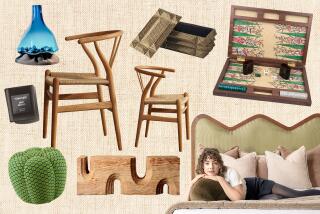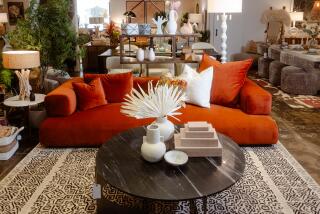Wright’s Vision Clear in Furniture
- Share via
Architect Frank Lloyd Wright, who died in 1959, is still revered the world over for his visionary structures. Now there is a clamor over the furniture he designed to complement them.
Interest in his Arts and Crafts and modernist pieces from the early part of the century has been growing for two decades, according to Thomas A. Heinz, a Chicago architect.
“Wright’s furniture may not look so good in a colonial house,” he said, “but it fits beautifully into a fairly broad group of buildings, including Arts and Crafts bungalows and modern houses.”
Heinz has written 16 books about Wright and for 20 years reproduced Wright furniture on a limited basis. He sold his interests to Bexley Heath Ltd. of Grand Rapids, Mich., which introduced 17 reproductions nationally in the spring. The line is primarily Arts and Crafts design from the early 1900s. Prices range from $450 for a lamp to $12,000 for a leather sofa.
Bexley Heath will introduce five more pieces at the fall furniture market in High Point, N.C., in October, including an upholstered chair originally designed for the Imperial Hotel in Tokyo.
Another spring roll-out was a collection of 11 pieces from Fallingwater, his famous house in Bear Run, Pa., built in 1936 for Pittsburgh department store magnate Edgar Kaufman. Today, it is a house museum operated by the Western Pennsylvania Conservancy. The conservancy authorized the furniture reproductions and will receive some of the proceeds.
The collection--a bed, tables, lamps, a living room desk and two hassocks--will be sold at the museum or through Dennis Miller Associates, a distributor in New York City ([212] 355-4550). Prices range from $315 for a lamp to $9,188 for the living room desk. The dining table is $6,313.
The new lines join a long-standing furniture group manufactured by the Italian firm Cassina ([800] 770-3568) under the auspices of the Frank Lloyd Wright Foundation in Taliesin, Ariz., as well as a diverse group of other Wright-related products.
These range from lamps, fabrics and rugs to stained glass windows and small accessories. Some are adaptations loosely based on the originals, but others are close copies of his creations.
There’s little chance that Wright designs will overlap in the marketplace. He was one of the most prolific architects in America or anywhere. It has been estimated that Wright produced about 1,000 architectural designs, half of which were built.
“About 400 of the 500 are still standing, and 40 of those are open to the public,” says Steve Kroeter, New York-based marketing consultant to the Frank Lloyd Wright Foundation.
Although most of Wright’s home furnishings were custom pieces for his structures, he dabbled in the mass market. In 1955 he created a variety of home furnishings for leading U.S. manufacturers, including furniture from Heritage/Henredon, fabrics and wall coverings from Schumacher and paint by Martin Senour. The collection was presented in the November 1955 issue of House Beautiful magazine.
This fall, the original 36 Martin Senour colors will be reintroduced, says Penny Fowler, administrator of the fine and decorative arts collection at the Frank Lloyd Wright Foundation. The foundation also has authorized a line of concrete urns and garden sculptures.
“Wright designed so many home furnishings because of his organic philosophy that everything had to be integral to the whole,” Fowler said. “He would select a pattern from nature and carry it throughout the house into the furniture, fabrics and home accessories such as vases, candlesticks and andirons.
“We have well over 200 drawings for chairs alone. The archive also includes over 23,000 drawings, any of which might serve as an inspiration for a design.”






